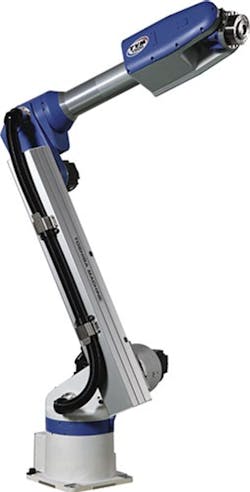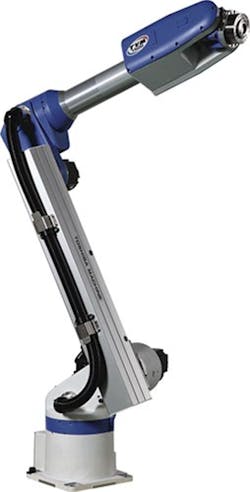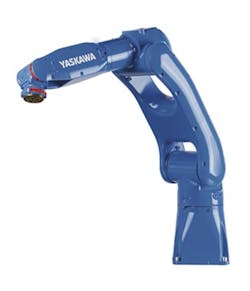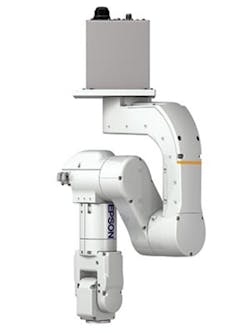Industrial Six-axis robots are among the most versatile options available in the workplace. They offer greater flexibility and are capable of performing a wider variety of applications than robots with fewer axes. They frequently are used in injection molding operations to remove finished parts from molds. The repetitive nature of the job is well-suited for six-axis robots, which can maintain consistent timing and efficiency without a need for breaks, thus increasing productivity.
Robots also can assist with other repetitive functions, such as loading, unloading, stacking and lifting. Their popularity is increasing as the technology becomes more affordable and easier to use.
That's especially true for the plastics industry, said Dean Elkins, senior GM of sales for the Motoman Robotics Division of Yaskawa America. "One of the biggest trends is predicated on speed," he said. "Machines are getting smaller and lighter and fitting into molding machines faster. They are getting easier and easier to use."
TM Robotics/Toshiba Machine
TM Robotics, in partnership with Toshiba Machine, launched Toshiba Machine's newest TVM six-axis line of robots in April.
The cost-effective TVM series is vertically articulated and can work in plants that make any of a number of products, including automotive components, packaging and medical parts, due to its reliability and productivity in transfer and assembly operations.
The new lightweight robots have greater reach and payload capacity than Toshiba Machine's prior offerings.
"We're very excited that this TVM robot series takes Toshiba Machine into the middle market of six-axis robots," said Nigel Smith, CEO of TM Robotics, which markets Toshiba Machine's line of products. "It expands our reach capacity up to 1.7 meters (67.5 inches) and also expands our payload capacity up to 20 kilos (44 pounds)."
The robots are particularly well-suited for the plastics industry because of their compatibility with Toshiba Machine's injection molding machines, Smith said.
He said the six-axis robot could be used to unload molds and perform downstream operations. The new robots' larger payloads and greater reach increase their value to injection molders.
"As the injection molding machines get larger, the processing time or the mold time becomes longer," Smith said. "Effectively, with the reach of these robots, you could have one robot unloading two different machines, which obviously gives the customer a bigger return on his investment."
Toshiba Machine released three models of the TVM. They are:• TVM900/TSL3200E with a reach of about 44.3 inches and a payload of 44 pounds• TVM1200/TSL3200E with a reach of 55.8 inches and a payload of 33 pounds• TVM1500/TSL3200E with a reach of 67.5 inches and a payload of 22 pounds.
The TVM robots can be automated easily, without the need to program CAD data, for bin-picking functions when the robots are combined with Toshiba Machine's TSVision3D robot vision-recognition package.
Motoman Robotics Division of Yaskawa America
Yaskawa Motoman recently introduced its GP series of robots, which is ideal for high-speed assembly and handling applications, according to the company.
The new models — the GP7, GP8 and GP12 — offer the highest payloads and fastest speeds in their class, according to the company.
In addition, the robots offer improved acceleration and deceleration control for greater productivity.
The robots also are compact, with a small footprint and slim arm design that allow them to be placed near other equipment.
"One of the other things is we have worked to minimize the number of cables that run in and out of the robot," Elkins said.
The GP-series robots are controlled by Yaskawa's new compact YRC1000 controller, which does not require a transformer for input voltages ranging from 380 volts to 480 volts. The YRC1000 measures only 23.5 inches wide by 19.3 inches high by 16.8 inches deep. That's about half the size of a previous model.
"This controller is a very powerful, space-saving design," Elkins said. "Now, when you get involved in plastics applications, you can install it in the base of a machine to save floor space."
The GP7 and GP8 models are fast and designed for high-volume assembly, handling and packaging processes. The design increases axis speeds as much as 39 percent, and the robots have greater reach, allowing them to be deployed in wider work areas.
In addition, with their slim arms, the robots have the flexibility to reach deep into the workspace. The GP7 offers a 15.4-pound payload capacity with a 36.5-inch horizontal reach and a 66.6-inch vertical reach. The GP8 offers a 17.6-pound payload capacity with a 28.6-inch horizontal reach and a 51.7-inch vertical reach.
The GP7 and GP8 feature an IP67 wash-down rating with an easy-to-clean surface that make them ideal for use in sanitary or harsh environments.
The GP12 robot features a 26.5-pound payload capacity and its axis speeds have been increased by up to 15 percent for increased productivity. It features a 56.7-inch horizontal reach and a 98.9-inch vertical reach. Its wrist is IP67 rated; it has a standard IP54-rated body, with an IP65-rated body available as an option.
All three models can be mounted to the floor, ceiling or walls.The series has numerous potential applications in the plastics industry.
"They can be used for injection molding extraction processes, mold insertion processes, and secondary processes of routering or degating," Elkins said. "They can trim parts, guide knives for ultrasonic cutting, or be used in water-jet applications."
They can also be used for bottle handling in the blow molding industry.
Epson Robots
In November, Epson Robots expanded its line of six-axis robots by introducing the Flexion N series, which features a compact folding arm.
The new series is compact for applications requiring smaller robots. The folding arm reduces space requirements by as much as 40 percent compared with standard six-axis robots, according to the company.
With its proprietary design, the robot is capable of very compact motions, keeping its arm and joints from sweeping out. This maximizes motion efficiency for faster cycle times while allowing operation in tight spaces.
"With the Flexion N series, Epson is proud to present an intelligent, compact solution and entirely new class of six-axis robots to meet the demanding needs of advanced manufacturing," said Gregg Brunnick, director of product management for Epson Robots.
The first robot Epson introduced in the lineup is the Flexion N2, which features a 17.7-inch reach and a 5.5-pound maximum payload.
The Flexion N series is available in ceiling and tabletop configurations.
Bruce Geiselman, senior staff reporter
For more information
Epson Robots,Carson, Calif., 562-290-5910, www.epsonrobots.com
TM Robotics Inc.,Elk Grove Village, Ill., 847-709-7308, www.tmrobotics.com
Yaskawa America Inc., Motoman Robotics Division,Miamisburg, Ohio, 937-847-6200, www.motoman.com
About the Author
Bruce Geiselman
Senior Staff Reporter Bruce Geiselman covers extrusion, blow molding, additive manufacturing, automation and end markets including automotive and packaging. He also writes features, including In Other Words and Problem Solved, for Plastics Machinery & Manufacturing, Plastics Recycling and The Journal of Blow Molding. He has extensive experience in daily and magazine journalism.



